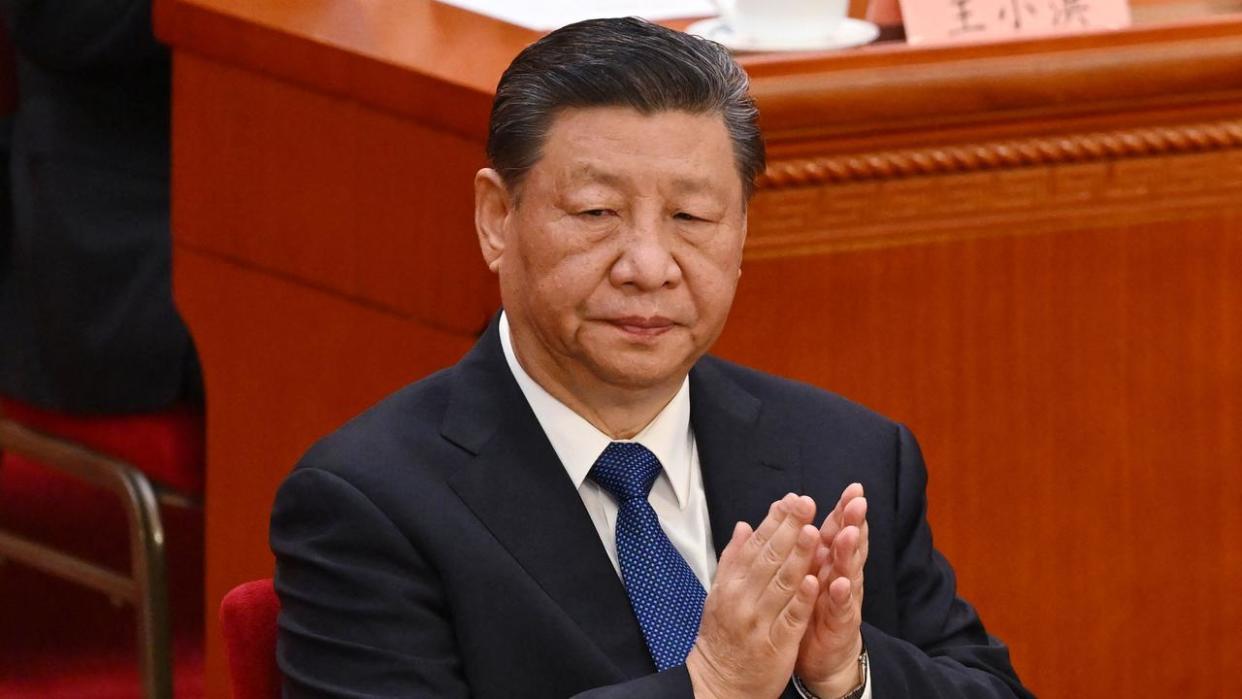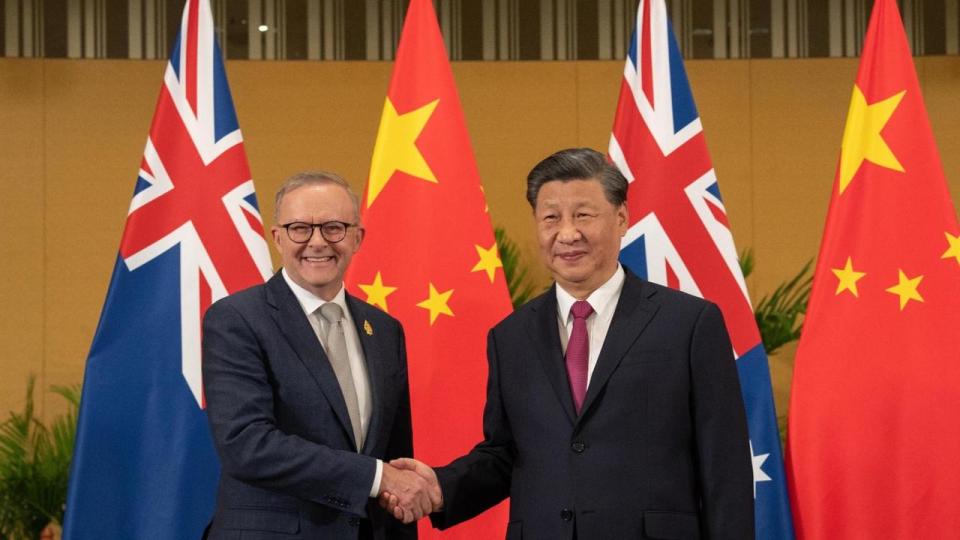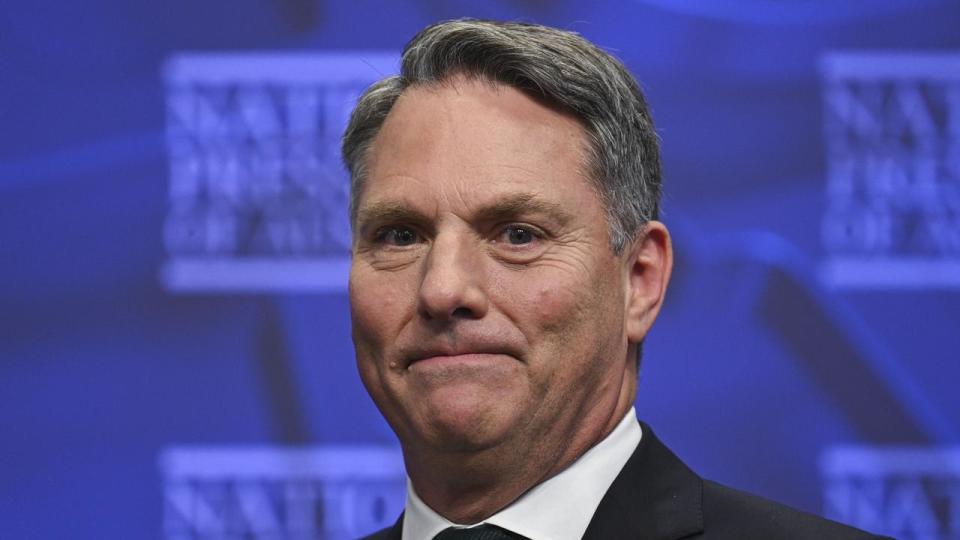China slams Aussie ‘Cold War mentality’

Beijing has taken aim at the Albanese government’s inaugural national defence strategy, urging Canberra to drop its “Cold War mentality” as it denied China posed any risk to regional stability.
Defence Minister Richard Marles unveiled the strategy on Wednesday, announcing Australia would bolster its navy over the next decade to compete with an increasingly aggressive and coercive China in pursuit of its “strategic objectives”.
He warned China’s military build up and tensions with the United States had created an environment “where the risk of miscalculation is more ominous and the consequences more severe”.
Overnight, Chinese foreign ministry spokesman Lin Jian said China posed “no threat” to the region, pointing the finger instead at “major countries outside the region” who posed the biggest risk to regional security.

“We stay committed to the peace and stability of the Asia-Pacific region and the wider world, and pose no threat to any country,” he said.
In a veiled critique of the United States, Mr Lin said the formation of “exclusive groupings” had stoked “bloc confrontation” and muddied the waters in the South China Sea.
“As if the world needed any more instability. China firmly opposes it,” he said.
“We hope Australia will correctly view China’s development and strategic intentions, abandon the Cold War mentality, do more things to keep the region peaceful and stable, and stop buzzing about China.”
THE COST: The AUKUS program is forecast to cost $268bn to $368bn between now and the mid 2050s, or about 0.15 per cent of Australia’s GDP. The government will spend $9bn over the next four years, offset by cuts in Defence. Of this figure, about $2.5bn will be invested in US shipyards to boost production of the Virginia-class submarines and $500m in Britain. The remaining $5bn will be invested domestically, including $2bn for new South Australian infrastructure.
INDUSTRY: The trilateral nature of AUKUS will give rise to a unified supply chain, with all three partner countries contributing to each other’s industrial bases. This could involve SA companies creating parts to be fitted on Virginia-class submarines in the US. There will also be opportunities to sustain subs that will be rotating through HMAS Stirling – and the three US subs Australia will buy in the 2030s.
FORWARD ROTATIONS: The US plans to increase nuclear submarine port visits to Australia starting this year. This will allow Australian sailors to join US crews for training. The British navy will begin increasing visits in 2026. As early as 2027, Britain and the US will establish a rotational presence of one Astute-class submarine and four Virginia-class submarines at HMAS Stirling near Perth. It will be dubbed “Submarine Rotational Force - West”, boosting the presence of nuclear-powered submarines in the region while Australia works on acquiring its own nuclear fleet.
JOBS AND SKILLS: AUKUS will create 20,000 direct jobs across Australia over the next 30 years, including up to 8500 direct jobs in the industrial workforce alone. More than half – up to 5500 – of these will be in SA when construction at the Osborne shipyard reaches its peak in 20 to 30 years. Australia is facing a worrying skills shortage, particularly in nuclear expertise. Measures to address this shortfall include sending hundreds of civilian workers to learn in US and British shipyards. Navy officers will study nuclear courses in the two countries and be embedded on US and British nuclear submarines. Extra places in STEM courses will be added to SA universities and a shipbuilding academy will be created at Osborne.
INFRASTRUCTURE: Work will begin this year on a new state-of-the-art submarine shipyard at Osborne. Full details about the expansion have not been released yet, but last year the Coalition announced the existing shipyard would swell in size from 20ha to 65ha. The site earmarked for new infrastructure is just north of the existing yard. Artist’s impressions shows new infrastructure wrapping around Mutton Cove Conservation Reserve.
It will be almost three times larger than the yard forecast for the now-dumped Attack-class program. At least $2bn will be spent on new SA infrastructure over the forward estimates. Up to $8bn will be spent over the next decade upgrading HMAS Stirling near Perth.
WHAT WE'RE GETTING: Australia will buy three US Virginia-class nuclear submarines from 2033 to 2039. The US-made submarines could be a mix of new and second-hand vessels. This is seen as a stopgap measure to ensure Australia can operate nuclear-powered submarines in the highly contested Asia-Pacific region as quickly as possible. Starting this decade, Australia will begin constructing a fleet of SSN-AUKUS nuclear submarines designed in Britain and constructed at Adelaide’s Osborne shipyard. The first boat will be ready in 2042.
GLOBAL REACTION: No country is more infuriated with the AUKUS security pact than China. Beijing has been running an active misinformation campaign, spreading lies in attempts to undermine the pact. China falsely claimed Australia intends to use uranium in the submarine reactors to manufacture nuclear weapons and foreign ministry spokesman Wang Wenbin said the AUKUS nations were walking “down the path of error and danger”. France was left stunned and angry when former PM Scott Morrison dumped the $90bn Attack-class deal but Defence Minister Richard Marles says the relationship has been mended.
WHY WE'RE GOING NUCLEAR: War in Ukraine and China’s belligerence means Australia needs a more capable navy to protect its vulnerable trade routes and underwater cables. Diesel-electric subs can’t go as far and are not as stealthy as nuclear subs, which can stay under water indefinitely.
COLLINS SUBS: The $6.4bn Collins-class life-of-type extension will continue as planned. Each boat will undergo upgrades every two years from 2026. But overhauling all six may be unnecessary as Australia acquires Virginia-class subs in the 2030s.
NUCLEAR CONCERNS: Australia has made assurances it will uphold the “highest non-proliferation standards” set by the International Atomic Energy Agency. The agency’s head visited Australia and gave the federal government a glowing review of its commitment to non-proliferation. A nuclear submarine lasts about 33 years, then the nuclear material in the reactor must be disposed of. Within a year, the federal government will announce a waste site.
Mr Marles on Thursday doubled down on his comments, saying the national strategy had been underpinned by the “very complex set of strategic circumstances”.
“We are seeing a very significant military build-up in the region. China is engaging in the biggest conventional military build-up since the end of the Second World War. That is just a fact,” he said.
“And it does change the strategic landscape. It’s not just ourselves, but it’s all countries of the region and in fact, the world.
“We need to be making sure that we are the most capable nation that we can be, that we can resist coercion.”
Asked what coercion might look like, he pointed to sea trade operations.
“The reason why we make the observation that an invasion of Australia is a very unlikely scenario, no matter what happens, is because any adversary that wished to do us harm could do so much to us before ever setting foot on Australian soil, and disrupting those specific sea lines of communication, which I’ve described, would obviously achieve that,” Mr Marles said.
The Coalition’s home affairs spokesman, James Paterson, said he wished the grounds for the Chinese government to be angry were “stronger than they actually are”, hitting out at the Albanese government’s decision to slash programs.

During his speech to the National Press Club on Wednesday, Mr Marles confirmed the defence budget would grow by $50bn over the next decade, but just 10 per cent of that would be accessed in the next four years.
The government says it will claw back $72bn from dumped weapons programs to pay for more submarines, ships, missiles and drones. Mr Marles said the reality was the nation’s defence hinged on collective regional stability.
“As a medium power, we are never going to bring to bear the kind of military capability that exists in the United States or China,” he told the National Press Club.
“The strategic problem that we are trying to meet, that we’re trying to solve, is making sure that in a much less certain world in the future, we are able to resist coercion, and maintain Australia’s way of life.”
Senator Paterson said Mr Marles had slashed $72bn of cuts to defence capabilities.
“That adds to the $8bn in cuts that he’s previously announced, so $80bn of cuts to defence, and to compensate for that, he says we’re going to have an extra $5.7bn of spending over the next four years,” he said.
“It’s likely that will only modestly compensate for inflation and cost overruns, which are common on defence projects.
“So what actual new capability are we going to acquire that has somehow raised the ire of China’s government? It’s not clear to me based on early reading of the defence strategy or the integrated investment plan.”


